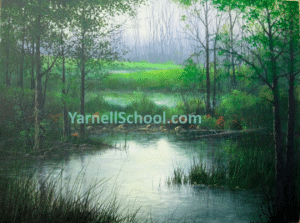
Composition is the backbone of any successful landscape painting. Avoid the temptation, and this pitfall when painting landscapes, to place elements haphazardly on your canvas. Instead, take the time to sketch out your composition before diving in. Use the rule of thirds to create balance and draw the viewer’s eye into the scene. Remember, a well-composed landscape not only provides structure but also enhances the narrative of your artwork.
Light can dramatically alter the mood of your landscape. Avoid painting in flat, even lighting, which can make your artwork feel lifeless. Instead, study how natural light interacts with your subject. Capture the magic of golden hour, the drama of stormy skies, or the tranquility of misty mornings. By paying attention to light and atmosphere, you can infuse your painting with depth and emotion, creating a captivating experience for your audience, thus avoiding this pitfall when painting landscapes.
While it’s tempting to meticulously render every blade of grass or leaf, overworking details can detract from the overall impact of your painting. Avoid getting caught up in minutiae and remember the importance of simplicity. Focus on capturing the essence of the landscape rather than every detail. Embrace the beauty of suggestion; sometimes, less is more, and a few well-placed strokes can speak volumes.
A common mistake in landscape painting is a lack of depth. Avoid painting all elements at the same level of detail and intensity. Create a sense of space by distinguishing between the foreground, middleground, and background. Use atmospheric perspective—lighter colors and less detail in the background—to create the illusion of distance. This technique not only adds depth but also invites the viewer to journey through your landscape painting and avoiding this pitfall.
While it can be tempting to stick with a few familiar colors, restricting your palette can lead to dull results. Avoid the trap of monotony by experimenting with a wider range of colors. Nature is rich and vibrant, offering an array of hues that can bring your landscape to life. Don’t be afraid to mix unexpected colors and explore the emotional impact of your choices. A dynamic palette can transform an ordinary scene into a breathtaking masterpiece.
In the heat of creation, it’s easy to lose perspective. Avoid the habit of painting too close to your canvas without stepping back to assess your work. Regularly take a few steps back to evaluate your piece from a distance. This practice allows you to see the overall composition, balance, and color harmony, helping you make necessary adjustments before it’s too late. A fresh perspective can ignite innovative ideas and inspire your next steps.
At Yarnell School of Fine Art, we believe that the journey of creating art should be as enriching as the final piece itself. By avoiding these common pitfalls, you can enhance your landscape painting and truly capture the beauty of the world around you. Remember, every brushstroke is an opportunity for growth, and every canvas is a new adventure waiting to unfold. Embrace the process, learn from your experiences, and let your passion for art shine through. Happy painting!